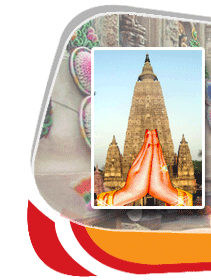 |
 |
 |
 |
Buddhism Guide |
More On Bodh Gaya |
Information |

The History of Buddhism :
The history of Buddhism traces back to the teachings of Lord Buddha after He attained enlightenment in 528 BCE under the Bodhi tree at Bodh Gaya, India. Ater attaining enlightenment, Lord Buddha spent the rest of His life in making others aware of the truth of life. It was after His Mahaparinirvana in 483 BCE , when the first Buddhist council was convened at Rajagriha in India , when 500 monks assembled under the guidance of Mahakashyapa, and the teachings of The Buddha were compiled by His chief disciple, Ananda in the form of a holy Pali canon, Tripitaka, which meant the three baskets.
The Buddhism In India
483 BCE - 250 BCEThe Second Buddhist council that was held in Vaishali in 383 BCE, one hundred years after the Buddha's death, witnessed the conflict of the Buddhist ideologies, which ultimately resulted in the formation of two schools - Sthaviravadins and Mahasanghikas. The Sthaviravadins, later known as Theravadins were of orthodox views and wanted the monks to lead an ascetic's life, whereas the Mahasanghikas or the Mahayanas were of liberal view and wanted the conducts to be flexible. The conflict between both the sects became so intense that later The Indian emperor, Ashoka had to convene the third Buddhist council in his kingdom's capital at Patliputra in 250 BCE to purify Buddhism and reconcile the two sects.
Ashoka (269 BCE - 232 BCE)
There is a story which tells about a poor young boy, who once when went to see Gautam Buddha, had nothing to give Him as a gift. The poor young child was desperate to present the Buddha something, and so, he collected a handful of dust and innocently presented it to the Buddha. The Buddha smiled and accepted it with the same graciousness He used to accept the gifts of wealthy admirers. That innocent boy, it is said, was reborn as the Emperor Ashoka. The rise of Buddhism had not reached the height prior to the upcoming of Ashoka, who when converted into a Buddhist, gave the sect a glory that it should have got earlier! Ashoka made 'Dhamma' his state religion, which was entirely based upon the teachings of Lord Buddha, and got the Dhamma engraved on the rock edicts throughout his empire. He also sent the Buddhist monks, including his son, Mahindra and daughter, Sanghamitra, to different parts of the world as far as Egypt, Palestine, Greece, Southeast Asia and Central Asia to spread the philosophy of Buddhism. Though Ashoka had convened the third Buddhist council to establish harmony between two sects, but unfortunately he could not succeed. However, both the sects agreed upon the purification of Buddhism.
233 BCE - 1st century BCE
After the death of Ashoka, Buddhism again went through the period of suppression especially by the Sunga rulers, during 185 BCE - 73 BCE.
1st century CE - 8th century CE
The following era till 8th century CE was an era of Buddhism, in which a large section of people followed the principles of Buddhism. Again the Indian emperors started giving royal patronage to Buddhism. Kanishka, a Kushana emperor, convened the fourth Buddhist council in 100 CE in Kashmir or Jalandhar, which is generally associated with the rise of the Mahayana sect.
8th century CE onwards
But the 'dark age' began in the 8th century CE with the revival of Hinduism in India as people started going back to Hinduism. The Buddhist school was further shaken by jolts from the luxurious practices of the Buddhist monks, intermingling of the Tantricism with that of Hinduism and finally, the Turks' invasion of India, who targeted the Buddhist temples and monasteries. As a result, Buddhism got confined to parts of the Indian Himalayan region till early 20th century, when the establishment of MahaBodhi society and conversion of an Indian leader, B.R. Ambedkar with his followers into Buddhism favoured the revival of Buddhism in India.